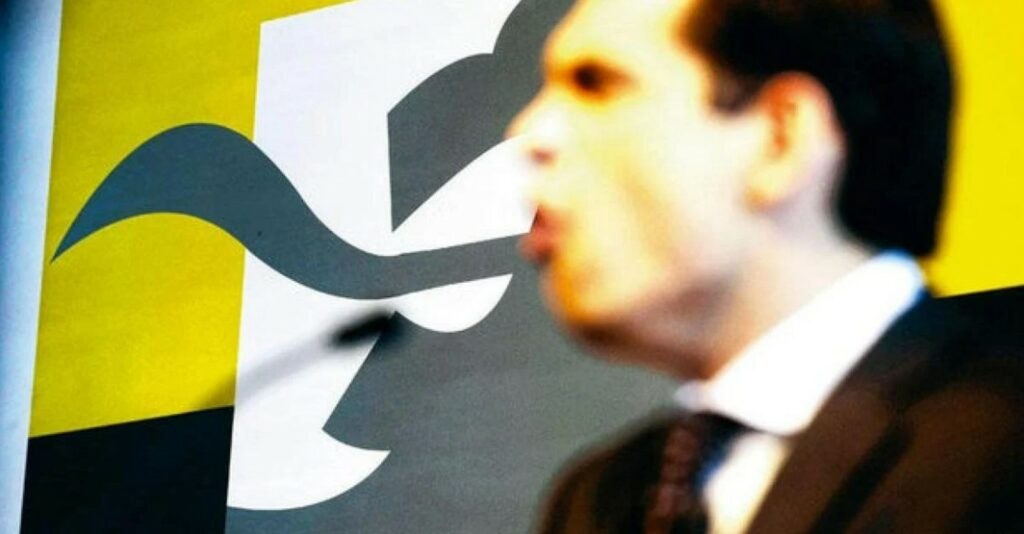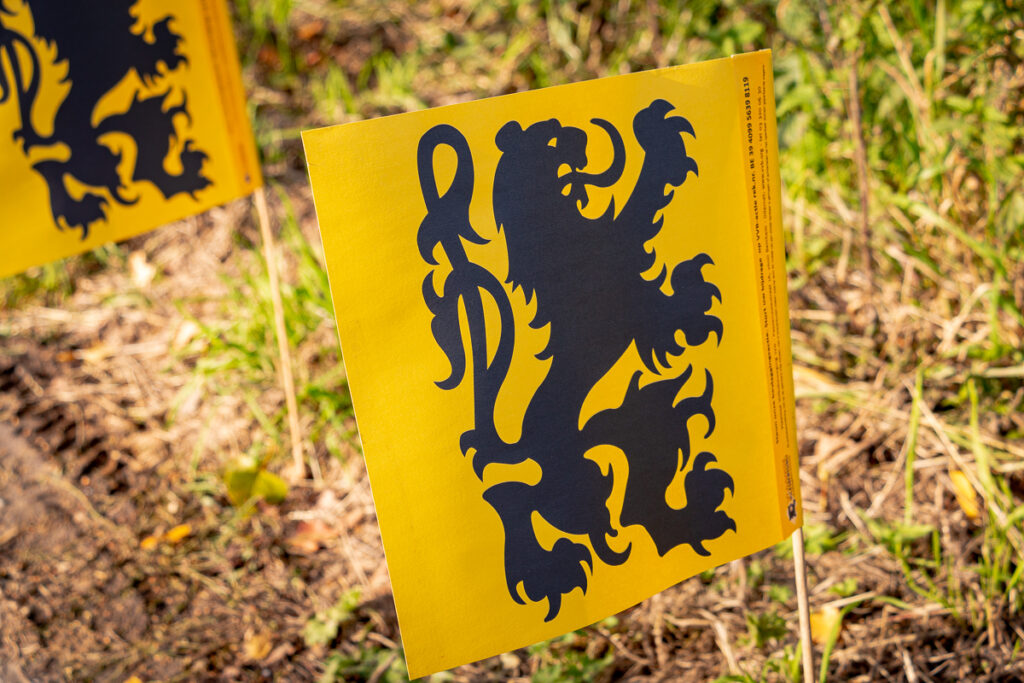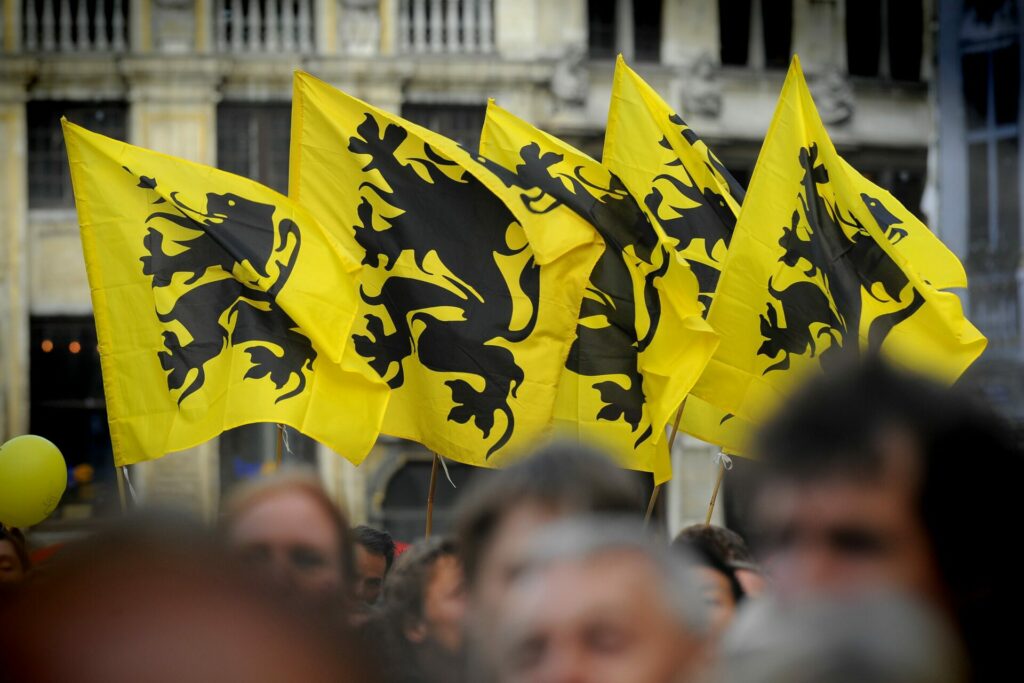While Flanders' officially recognised flag shows a lion with red claws and a red tongue, many other frequently-used flags depict a fully black lion. Where do the different versions come from, and why is one so often associated with the far-right?
For many, the black-yellow lion cannot be separated from the Flemish collaboration during the Second World War, with critics referring to numerous images of old posters on which Nazis and the lion would be standing next to each other in a brotherly fashion. They see the use of that flag as an inherent approval of that tarnished past.
In practice, however, the situation and history of the black-yellow lion are a bit more complicated.
When the Flemish far-right Vlaams Belang party changed their name in 2004, a completely black lion appeared in their logo for the first time – the most important symbol of the Flemish movement since the end of the 19th century.

Flemish far-right Vlaams Belang leader Tom Van Grieken in front of the party's logo. Credit: Belga
Since the 12th century, the Flemish Lion has appeared in the coats of arms of several Flemish counts, as a souvenir of the Crusades. Philip I, commonly known as Philip of Alsace, wore a lion that was standing on its hind legs for the first time in 1136. Importantly, however, this lion had a red tongue and red claws.
Thanks in part to the works of famous Flemish author Hendrik Conscience – considered a pioneer of Dutch-language literature at a time when Belgium's upper classes were dominated by the French language – such as the historical novel De Leeuw van Vlaanderen (The Lion of Flanders), the lion became a symbol of the Flemish movement in the 19th century.
However, it was the First World War that brings about the final incompatibility between the Belgian flag and the Flemish lion one; the aversion to the tricolour gave rise to a whole discussion about whether or not the tongue and claws of the Flemish lion should be red.
Therefore, people supporting the Flemish Movement – called 'flamingants' in both Dutch and French – began to depict the lion completely in black on a yellow background, leaving out the red that would give the flag all of Belgium's colours.
Jewish and/or communist red?
During the Second World War, the aversion to red in the Flemish Lion and the Belgian tricolour reached its peak, illustrated by the shocking saying "the red hides the face of the laughing Jew," said Koen van Keer of the ADVN heritage centre for national movements in Europe. At that time during WWII, an important part of the population made very little distinction between "Jewish" and "Communist," he added.
In 1973, when the official logo for the Flemish Community was chosen, the choice went to Philip of Alsace's original Flemish Lion based on the medieval description: with its red tongue and red claws. The "real" flamingants – read nationalists – however, held on to "their" battle flag with the fully black lion, which for them still symbolises Flemish emancipation.
Members of the Flemish separatist, rightwing N-VA party, including group leader in the Federal Parliament, Peter De Roover, stressed that the fact that this flag was also used by movements collaborating with the Nazi occupiers at the time does not make it a "collaboration flag." Still, as Vlaams Belang claimed the black lion for itself, other pro-Flemish parties fear that the lion flag will now always be associated with a xenophobic party.

The fully black lion. Credit: Vlaamse Volksbeweging
"That flag was indeed used by collaborators in World War I and World War II. This is logical because the radical Flemish movement had a large share in the collaboration," historian at UGent Bruno De Wever, brother of N-VA leader Bart De Wever, told Het Nieuwsblad, while stressing that just because a symbol has been used in a particular context does not mean that it completely coincides with it.
"Under the Belgian flag, for example, we have colonised Congo for decades. But Belgian history is also more than that period," De Wever said, adding that both lions – and many other variants as well – have been used side by side for a long time.
"Since the emergence of the Flemish movement in the 19th century, the fully black lion in particular was in vogue. Even before the collaboration with Germany, that lion is often seen as the symbol for Flemish self-determination."
Translation of Tweet: "There are perhaps good reasons why that so-called 'battle flag' was replaced at a certain point by another Flemish Lion."
In the 19th-century Flemish Movement, there was no contradiction at all between Belgian patriotism and pro-Flemishness, explained De Wever said. "But then you get the emergence of anti-Belgian Flemish nationalism in the First World War. And that movement opted for the black and yellow Flemish Lion."
This is the flag that then became the so-called 'Flemish battle flag' of the more extreme Flemish Movement. "The most radical Flemish nationalists did indeed become involved in the collaboration, but you cannot say that the black and yellow lion is a symbol of collaboration. That is an exaggeration."
Professor and former Federal MP for N-VA Hendrik Vuye added that while it is true that the fully black Flemish lion has been used by collaboration movements, so has the Belgian flag. "The Belgian flag adorned the uniforms of Léon Degrelle's Walloon Legion, making that a collaboration flag as well if you only trace it back to the period 1940-1944. But of course, those flags are much older," he told VRT.
Resisting the Belgian establishment
Vuye, who is a Flemish nationalist and professor of Constitutional Law, refers to the case law of the European Court of Human Rights. "These flags are polysemous symbols: symbols that have multiple meanings. The flag with the black Flemish Lion has a different meaning if it were hung at a commemoration of a Nazi collaborator than if it were used within the Flemish Movement."
For him, banning such a polysemous symbol by reducing it to a limited period of history is a "pretty blatant violation of freedom of expression." Still, the use of the Flemish battle flag – and its connotations of collaboration, whether justified or not – has been the subject of an often emotional polemic between flamingants and Belgian nationalists since the 1950s.
Currently, the more radical Flemish nationalists striving for separatism (such as Vlaams Belang) or confederalism (N-VA), still regard this unrecognised black and yellow lion as a symbol of resistance and struggle against the so-called 'Belgian establishment.'
Related News
- Grave of Flemish Nazi collaborator destroyed for second time in six months
- Belgium should be split through 'extralegal reform' next year, says De Wever
- Belgian politics for dummies: Who is in power where?
In the run-up to the Federal Government formation in September 2020, for example, thousands of Vlaams Belang members and supporters mounted the 'battle flag' on top of their cars and drove to Brussels in protest of the coalition being formed – which not only excludes Flanders' two biggest parties but also has a Francophone majority.
For Flemish nationalists, the black-yellow flag is "the flag that has been least tarnished by concessions to the French speakers." The official Flemish flag with its red tongue and claws, on the other hand, is viewed as the flag of a Flanders that is restricted and has handed over its numerical (and therefore political) majority.
In recent months, as dissatisfaction with Belgium's Federal Government continues to grow and talk of confederalism and "extralegal reforms" is gaining traction, critics fear that the Flemish separatists Vlaams Belang and N-VA may come out as the big winners of the federal elections next year.

